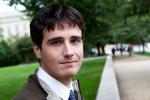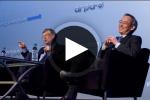
Greg Nielson holds a solar cell test prototype with a microscale lens array fastened to it. Together, the cell and lens help create a concentrated photovoltaic unit that when commercialized will revolutionize the way solar energy is collected. | Photo courtesy of Sandia National Lab
Next Monday, June 11 at 2 p.m. EDT, four researchers in the fields of nanotechnology and particle physics will participate in #LabChat Office Hours: Science of the Very Fast and Very Small.
Argonne nanoscientist Elena Rozhkova will be tweeting from @Argonne. She and her team are studying ways to enlist nanoparticles to treat brain cancer. This nano-bio technology may eventually provide an alternative form of therapy that targets only cancer cells and does not affect normal living tissue. Ask her questions about building materials atom by atom, the role of nanotechnology in diagnostic and therapeutic technology, or ‘liquid armor.’ Dr. Rozhkova talks more about her field and discoveries in the Lab Breakthroughs video and Q&A: Nanomaterials Discoveries Lead to Possible Cancer Treatment.
Brookhaven National Lab physicist Paul Sorensen will be tweeting from @BrookhavenLab. He studies what the universe might have looked like in the first microseconds after its birth, helping us to understand why the physical world works the way it does. He and his team do this by ‘smashing atoms’ with the 2.4-mile Relativistic Heavy Ion Collider (RHIC), a particle accelerator, and taking photos of it. Ask him questions about particle physics, really high-res 3D cameras (like the one he uses to snap shots of molecular explosions), and, of course, the beginning of the universe. He’s also a Presidential Early Career Award winner. Dr. Sorensen talks more about the RHIC in the Lab Breakthroughs video and Q&A: Exploring matter at the Dawn of Time.
Sandia National Lab semiconductor engineer Gregory Nielson and postdoctoral appointee Jose Luis Cruz-Campa will be tweeting from @SandiaLabs. The two engineers are responsible for the glitter-sized photovoltaic (PV) cells that could revolutionize solar energy collection at the commercial level, and also in consumer and military equipment. They are experts in the micro- and nano-fabrication, and microelectromechanical systems (MEMS). Ask them about the microsystems industry, how they are building devices one millimeter wide (a penny is 19 mm wide), and where they see their technology heading in the next 10 years. They discuss their discoveries at length in the Lab Breakthrough video and Q&A: Microelectronic Photovoltaics.
This Office Hours tweetchat is part of the Lab Breakthrough video series, which highlights the incredible technological feats accomplished in fundamental and applied research. Check out the Q&A’s with other Lab Breakthroughs researchers on the energy.gov topic page or see the full video series on the Lab Breakthrough YouTube playlist.
Can’t make it to the tweetchat? Use #labchat in a tweet anytime between now and Monday for researchers to address your questions or comments. The tweetchat will be moderated by @energy, so even if you don’t use Twitter, you can e-mail your questions. We’ll pass them along during the tweetchat. We will also pass along questions and comments posted on Facebook.






